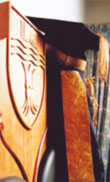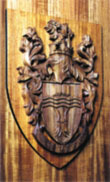Ceremonial symbols
University chair
 A gift from the Wagga Wagga City Council
A gift from the Wagga Wagga City Council
The University chairs used for ceremonial occasions, including graduations, and investitures, held in Australia were designed by Mr David Upfill-Brown, who is also the creator of well-known pieces of ceremonial furniture including the Speaker's Chair in the House of Representatives in the Federal Parliament of Australia in Canberra. He also developed the concept and crafted the three ceremonial chairs that complement the University Lectern, from Tasmanian Blackwood. The Chancellor's chair is embellished with a carved representation of the Sturt Desert Pea which is also incorporated into the finials of the backrest.
University gowns
 The history of ceremonial and academic dress reaches back to the days of the world's oldest universities. As universities and colleges developed throughout the Commonwealth of Nations they mostly chose academic dress modelled on those established for the members of Oxford and Cambridge. When they were established in the early 1970s, both of the University's immediate predecessor institutions chose to follow this tradition. The University continues this practice. The rules governing ceremonial dress are set out in the Ceremonial Dress Policy and the rules governing academic dress are set out in the Graduation Regulations.
The history of ceremonial and academic dress reaches back to the days of the world's oldest universities. As universities and colleges developed throughout the Commonwealth of Nations they mostly chose academic dress modelled on those established for the members of Oxford and Cambridge. When they were established in the early 1970s, both of the University's immediate predecessor institutions chose to follow this tradition. The University continues this practice. The rules governing ceremonial dress are set out in the Ceremonial Dress Policy and the rules governing academic dress are set out in the Graduation Regulations.
Chancellor's Gown
The Chancellor's Gown and Trencher are similar to those worn by the Chancellor of the University of Oxford. The Chancellor wears a black damask gown with nine metallic 35mm gold oak-leaf bands on the sleeve with a 70mm wide gold fabric band lined with 15mm gold oak-leaf on the outer side exists on the front facing. The collar, bottom edge of the gown, sleeves and rear vent are also lined with gold oak-leaf. On his or her head, the Chancellor wears a black mortarboard with gold oak-leaf on base and a gold tassel. The original Chancellor's gown was a gift from the City of Albury.
Deputy Chancellor's Gown
The Deputy Chancellor wears a black damask gown with five metallic 35mm gold oak-leaf bands on the sleeve and a 70mm wide red fabric (Pantone 1797) band lined with 15mm oak-leaf on the outer side exists on the front facing. The collar, bottom edge of the gown, sleeves and rear vent are also lined with gold oak-leaf banding. On his or her head, the Deputy Chancellor wears a black mortarboard with gold oak-leaf on base and a gold tassel.
Pro Chancellor's Gown
The Pro Chancellor wears a black damask gown with metallic 35mm gold oak-leaf bands at the arm opening, top and bottom of the sleeve. A 70mm wide red (Pantone 1797) fabric on the front facing. The collar, bottom edge of the gown, sleeves and rear vent are also lined with gold oak-leaf banding. On his or her head, the Pro Chancellor wears a black mortarboard with gold oak-leaf on base and a gold tassel.
Vice-Chancellor's Gown
The Vice-Chancellor wears a black damask gown with seven metallic 48mm gold oak-leaf bands on the sleeve. The front facing, the collar, the bottom edge of the gown, the sleeves and the rear vent are all lined with gold oak-leaf. On his or her head, the Vice-Chancellor wears a black mortarboard with gold oak-leaf on base and a gold tassel.
Council Gown
Members of the Council of the University wear a black gown manufactured to the same pattern as graduates holding a degree of Master. About the neck, he or she wears a stole of red fabric (Pantone 1797) consisting of two tails each one-and-a-half metres long and 10cm wide, fixed to a collar having the dimensions 33cm wide and 20cm deep, having square corners at the back of the neck. The stole is embroidered with the Coat of Arms, in full colour, on both tails at chest height. It is worn showing colour on both sides. On his or her head, the Council member will wear a black mortarboard and a black tassel.
University Secretary's Stole
The University Secretary wears a black gown manufactured to the same pattern as graduates holding a degree of Master.
About the neck, the University Secretary will wear a stole of black damask fabric consisting of two tails each one-and-a-half metres long and 10cm wide, fixed to a collar having the dimensions 33cm wide and 20cm deep, having square corners at the back of the neck. The stole is embroidered with the Coat of Arms, in full colour, on both tails at chest height. On his or her head, the University Secretary wears a black mortarboard and a black tassel.
Head of Campus and Provost Stole
Heads of Campus and Provosts wear a black gown manufactured to the same pattern as graduates holding a degree of Master. About his or her neck, the Head of Campus or Provost wears a stole of orange fabric (Pantone 166) consisting of two tails, each one-and-a-half metres long and 10cm wide, fixed to a collar having the dimensions 33cm wide and 20cm deep, having square corners at the back of the neck. The stole is embroidered with the Coat of Arms, in full colour, on both tails at chest height. It is worn showing colour on both sides. On his or her head, the Head of Campus or Provost wears a black mortarboard and a black tassel.
Academic Gowns
The academic gowns and colours of Charles Sturt University are set out in the academic dress regulations.
More about Charles Sturt Academic dress regulations
 University lectern
University lectern
A gift from Bathurst Regional Council
The University lectern is used for ceremonial occasions and was crafted in Tasmanian blackwood by Mr David Upfill-Brown. It features an intricate carving of the University's Coat of Arms. The lectern is housed in the Council Room at The Grange Chancellery at Charles Sturt University in Bathurst.
 University Mace
University Mace
The University Mace is the symbol of the University as an independent academy of scholars constituted under legal authority. During medieval times, the Mace was stamped with the Royal Arms and became the symbol of the authority and jurisdiction of the Crown. In academic ceremonies, the Mace is borne in procession immediately before the Chancellor, or representative of the University Council, and is placed before her or him during formal academic ceremonies.
The Charles Sturt University Mace is crafted from timbers indigenous to the locations of Charles Sturt University's Australian and Canadian campuses, including Australian Birds Eye Red Gum, Ancient Red Gum, Yellow Box, White Box and Canadian Rock Maple. The Dome of the Mace is inset with the University Coat of Arms in sterling silver, granted by Letters Patent to Charles Sturt University by the Royal College of Arms. The Mace reflects the traditions and authority of the University, while symbolising its multiple geographies and unique responsibility to the people of rural and regional Australia.
 University Message Stick
University Message Stick
A gift from Dubbo City Council
This wooden message stick draws on elements of local indigenous culture to represent the entire Wiradjuri nation, whose borders encompass the University's campuses at Albury-Wodonga, Bathurst, Dubbo, Orange and Wagga Wagga.
Young and old emu feathers, which hang from the mulga wood message stick, denote students of all ages. A possum painting represents the local Wilay Wiradjuri people and red ochre lines depict the Macquarie, Murrumbidgee and Murray Rivers on which the University's Albury-Wodonga, Bathurst, Dubbo and Wagga Wagga campuses are located.
